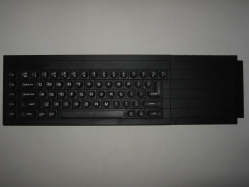Sinclair QL

Autopsy:
from Wikipedia:
The Sinclair QL (for Quantum Leap), was a personal computer launched by Sinclair Research in 1984, as the successor to the Sinclair ZX Spectrum. The QL was aimed at the hobbyist and small business markets, but failed to achieve commercial success.
The QL was originally conceived in 1981 under the code-name ZX83, as a portable computer for business users, with a built-in ultra-thin flat-screen CRT display (similar to the later TV80 pocket TV), printer and modem. As development progressed, and ZX83 became ZX84, it eventually became clear that the portability features were over-ambitious and the specification was reduced to a conventional desktop configuration.
Based on a Motorola 68008 processor clocked at 7.5 MHz, the QL included 128 KB of RAM (officially expandable to 640 KB) and could be connected to a monitor or TV for display. Two built-in Microdrive tape-loop cartridge drives (first seen as a peripheral for the Sinclair ZX Spectrum) provided mass storage, in place of the more expensive floppy disk drives found on similar systems of the era.
Interfaces included an expansion slot, ROM cartridge socket, dual RS-232 ports, proprietary QLAN local area network ports, dual joystick ports and an external Microdrive bus. Two video modes were available, 256×256 pixels with 8 RGB colours and per-pixel flashing, or 512×256 pixels with four colours (black, red, green and white). Both screen modes used a 32 KB framebuffer in main memory.
The hardware was capable of switching between two different areas of memory for the framebuffer, thus allowing double buffering. However, this would have used 64 KB of the standard machine’s 128 KB of RAM and there is no support for this feature in the QL’s original firmware. The alternative and much improved operating system Minerva does provide full support for the second framebuffer.
source: wikipedia


















Recent Comments